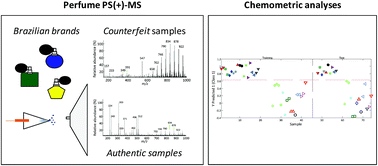Forensic discrimination between authentic and counterfeit perfumes using paper spray mass spectrometry and multivariate supervised classification†
Abstract
Perfumes are cosmetic products with high added value and worldwide consumption, which make them a potential target for counterfeiting. A novel, simple and rapid method was developed for the differentiation of samples of authentic and counterfeit perfumes by employing paper spray mass spectrometry (PS-MS) combined with multivariate supervised classification models: Partial Least Squares Discriminant Analysis (PLS-DA) and Soft Independent Modelling of Class Analogies (SIMCA). Samples of authentic (n = 29, consisting of 10 different brands from several batches and from the same producer) and seized counterfeit (n = 31) perfumes were analysed by PS-MS in the positive ionization mode and within a mass range of m/z 150–1000. An initial unsupervised exploratory model (Principal Component Analysis – PCA) provided a rough visual separation between the two classes. In contrast, PLS-DA and SIMCA provided good predictions, with low false positive and false negative rates for both models. The interpretation of informative vectors, i.e. regression coefficients and Variable Importance in Projection (VIP) scores obtained from the PLS-DA model allowed the detection of diagnostic ions for authentic and counterfeit samples. Some of the most discriminant ions for counterfeit perfumes were suggested to be attributed to compounds with allergenic properties.

- This article is part of the themed collection: Ambient Mass Spectrometry

 Please wait while we load your content...
Please wait while we load your content...